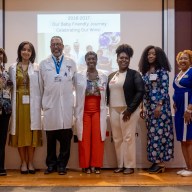The city must give residents more say over a planned $7-million makeover of Fort Greene Park’s Myrtle Avenue entrances, neighbors are demanding.
They believe longtime locals and public-housing residents have been left out of the conversation in favor of newcomers and real-estate interests in the gentrifying neighborhood — and now they want in.
“It would seem that the priority is to cater to the new luxury unit residents on Myrtle Avenue,” said local Sandy Reiburn in a letter to park steward group the Fort Greene Park Conservancy, which supports the changes. “Further discussions about monies spent and a redesign that seems more about social engineering than about the best and most welcoming use of our park are warranted.”
Around a hundred locals packed a meeting at the neighboring Ingersoll Houses last month where Parks Department honchos revealed their proposed changes — most significantly the corner of St. Edwards Street, where they plan to a clear a path to the Prison Ship Martyrs’ Monument by eliminating a stone wall and some granite platforms, and adding wheelchair ramps and a “water feature.”
The city says it based its blueprints on the park’s historic designs, along with feedback from a public forum attended by around 40 people in November — which it publicized through flyers posted around the neighborhood, at Ingersoll and Walt Whitman Houses tenant-association meetings, and through the local community board and business improvement district, according to a parks spokeswoman.
But many neighbors say they never got the memo and are annoyed they weren’t there to weigh in on construction that will impact them the most.
“Half of us black folks didn’t even know that you had a meeting in November — I certainly didn’t,” said one local from the Whitman Houses at the February gathering.
The city presented two very similar pitches at the February event — one has more trees — leading some of the aggrieved residents to believe it was just a fait accompli, possibly designed for fee-paying members of the park’s conservancy group and the developers who sponsor it.
“This plan appears to address some anticipated new residents to the neighborhood, without regard for the long-term residents who already have been using the park,” said neighbor Enid Braun.
The disgruntled locals’ gripes include the dramatic changes to the entrance’s current look, that ramps and other safety upgrades will only be added to a few entrances rather than all of them, and that construction will close that side of the park for a year or more — but mostly they just want more opportunities to influence the design.
“I want them to be open to proposals instead of saying, ‘This is the proposal, take it or leave it,’ ” said Ling Hsu, who lives a block from the park and has been distributing flyers around the neighborhood railing against what she calls a “top-down” design process since attending the February meeting. “We want to see [the city] work with us to evolve the design.”
Reps told locals at the meeting that some of their requests — like new playground equipment — aren’t possible, because the makeover is part of the so-called “Parks Without Borders” program, which is for opening up and beautifying park entrances.
And keeping features like the wall and mounds for the sake of “preservation” is misguided, as much of that was done in the 1970s and isn’t in line with the vision of famed park-itects Frederick Law Olmsted and Calvert Vaux, they said.
But the city claims nothing is set in stone and the whole point of the February meeting was to get feedback on the suggested designs — and there’ll be another chance to speak when the plan comes before the community board in May.
And because the park is part of the Fort Greene Historic District, the changes will also have to be okayed by the city’s Landmarks Preservation Commission.
The Fort Greene Park Conservancy declined to comment.
























